
Classroom Materials
The Center for Pollinator Research is dedicated to supporting K-12 educators by curating a variety of engaging and informative educational resources on pollinators.
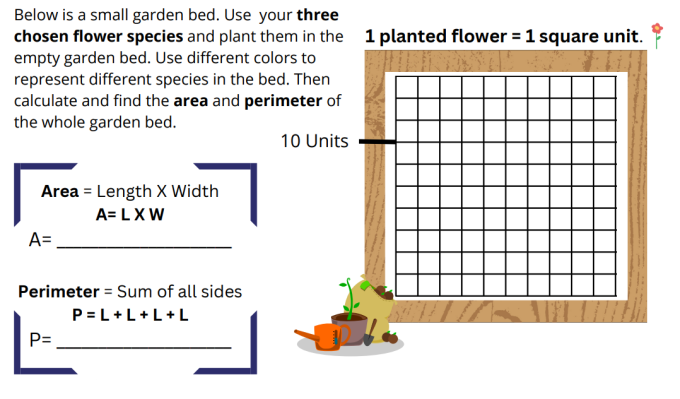
Bee-Healthy Farms
Grade Level: 3rd-5th Grade, Environmental Literacy
Overview: In this lesson, students will learn the importance of a healthy diet for living organisms. Students will learn about the importance of agriculture and how humans can affect food crops. Students will learn that the key role to a healthy agriculture is having a thriving population of pollinators. The class will hear stories from STEM-related careers in the agricultural industry and the importance of pollinators for our food. Students will gain knowledge and design their own pollinator garden. Students will choose different types of plants based on; native and non-native species, color, and growing season. Students will use math to measure their garden bed and will use formulas to find the area/perimeter of their garden bed. Students will be able to share the similarities and differences of their pollinator garden beds.

Bug of the Month: American Pelecinid Wasp
The October 2025 Bug of the Month is the American Pelecinid Wasp.
Written by PSU Ecology student Nina Gropp

Bug of the Month: Argyrotaenia velutinana
The June 2022 Bug of the Month is Argyrotaenia velutinana, the red-banded leaf roller.
By Laura Laiton Jimenez
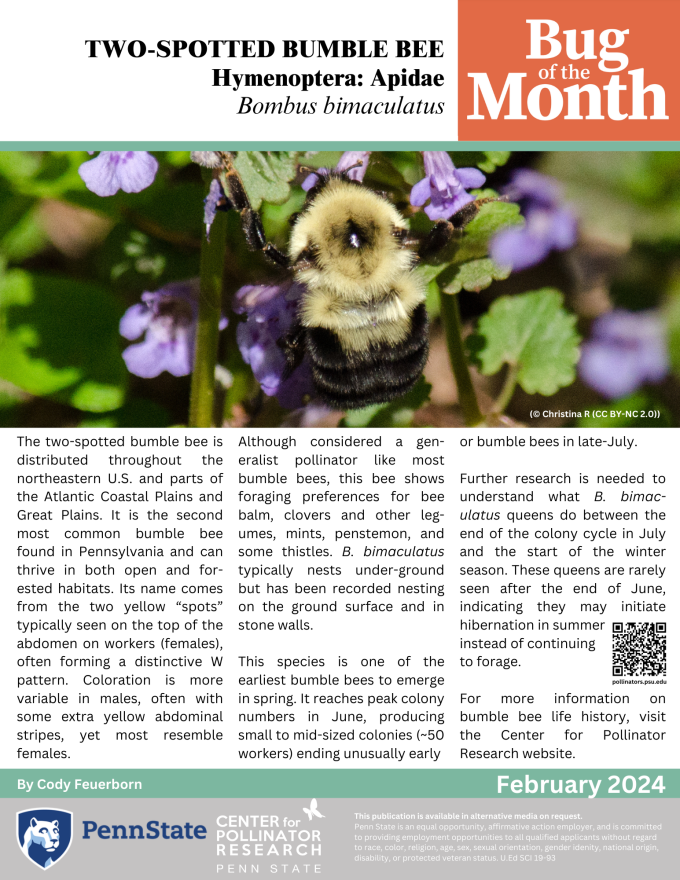
Bug of the Month: Bombus bimaculatus
The February 2024 Bug of the Month is Bombus bimaculatus, the two-spotted bumble bee.
By Cody Feuerborn
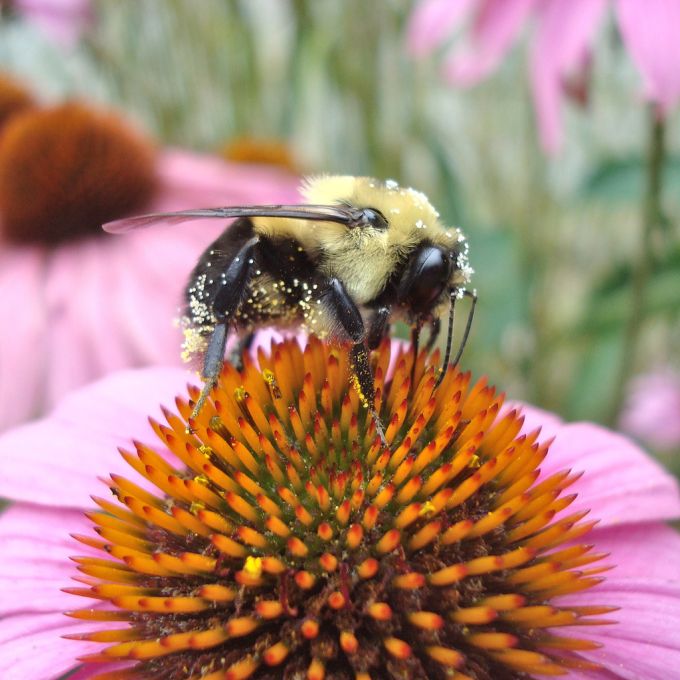
Bug of the Month: Bombus griseocollis
The March 2024 Bug of the Month is Bombus griseocollis, the brown-belted bumble bee.
By Cody Feuerborn

Bug of the Month: Bombus impatiens
The July 2021 Bug of the Month is Bombus impatiens, the common eastern bumble bee.
By Francesca Ferguson and Anna Cressman
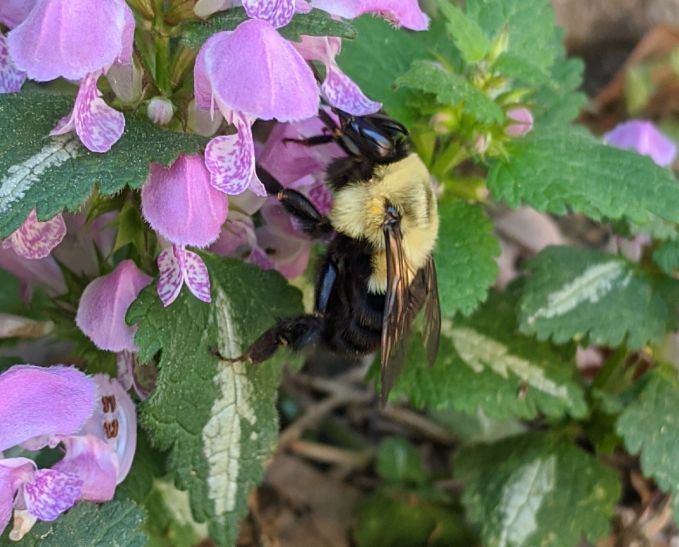
Bug of the Month: Bombus impatiens
The April 2024 Bug of the Month is Bombus impatiens, the common Eastern bumble bee.
By Cody Feuerborn

Bug of the Month: Cambarus bartonii
The September 2021 Bug of the Month is Cambarus bartonii, the common crayfish.
By Francesca Ferguson
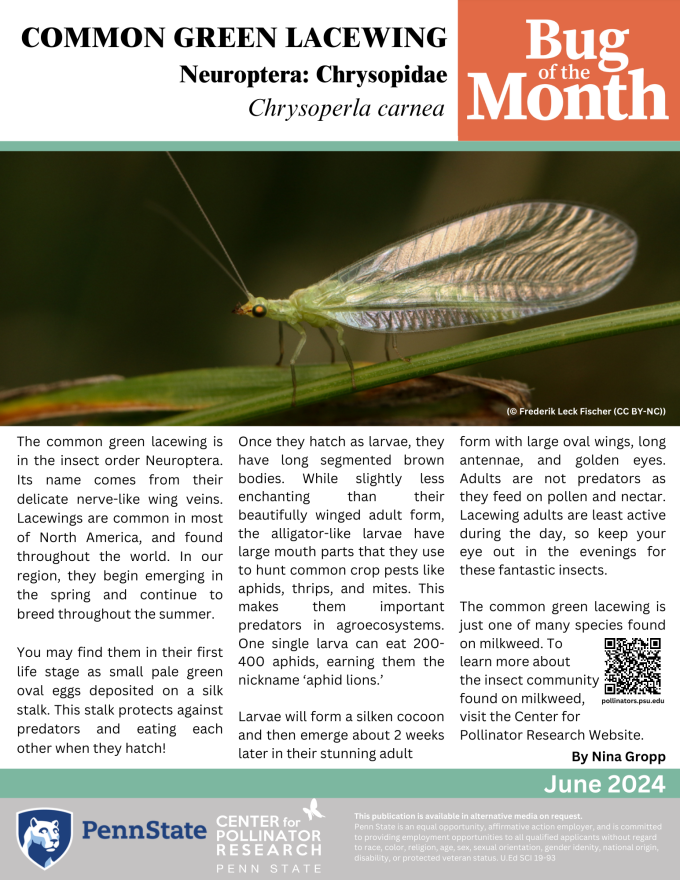
Bug of the Month: Chrysoperla carnea
The June 2024 Bug of the Month is Chrysoperla carnea, the common green lacewing.
By Nina Gropp

Bug of the Month: Coccinellidae species
The November 2022 Bug of the Month is Coccinellidae species, the lady beetles.
By Laura Laiton Jimenez

Bug of the Month: Corydalidae species
The August 2021 Bug of the Month is Corydalidae species, an aquatic insect called a hellgrammite.
By Francesca Ferguson

Bug of the Month: Daktulosphaira vitifoliae
The August 2022 Bug of the Month is Daktulosphaira vitifoliae, the grape phylloxera.
By Laura Laiton Jimenez

Bug of the Month: Diapheromera femorata
The March 2022 Bug of the Month is Diapheromera femorata, the walkingstick.
By Francesca Ferguson

Bug of the Month: Diplolepis bicolor
The November 2021 Bug of the Month is Diplolepis bicolor, the spiny rose gall wasp.
By Francesca Ferguson

Bug of the Month: Enchenopa binotata
The January 2023 Bug of the Month is Enchenopa binotata, the two-marked treehopper.
By Laura Laiton Jimenez

Bug of the Month: Epeorus nymph species
The May 2021 Bug of the Month is Epeorus species, also known as flat-headed or cookie-headed mayfly.
By Francesca Ferguson

Bug of the Month: Erythroneura species
The March 2023 Bug of the Month is Erythroneura species, grape leafhoppers.
By Laura Laiton Jimenez
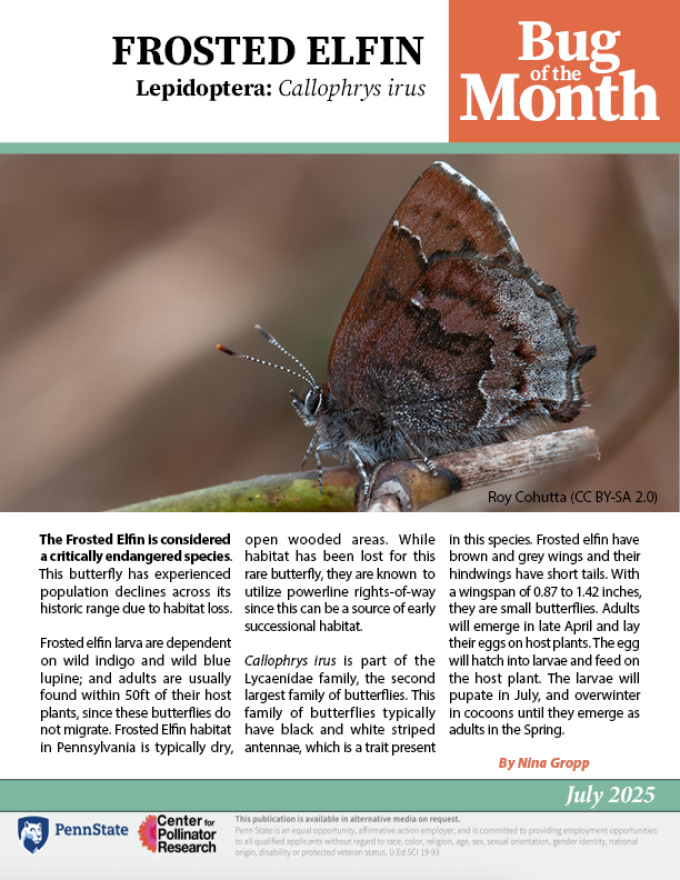
Bug of the Month: Frosted Elfin
The July 2025 Bug of the Month is the Frosted Elfin, a Critically Imperiled Pollinator in Pennsylvania and the focal species for this fall's 2025 PSU Great Insect Fair. Written by PSU Ecology student Nina Gropp.

Bug of the Month: Halyomorpha halys
The April 2023 Bug of the Month is Halyomorpha halys, the brown marmorated stink bug.
By Laura Laiton Jimenez

Bug of the Month: Kongsbergia species
The February 2022 Bug of the Month is Kongsbergia species, water mites.
By Francesca Ferguson

Bug of the Month: Lace bugs
The August 2025 Bug(s) of the Month are lace bugs in the Hemipteran family, Tingidae.
By Ecology student Nina Gropp

Bug of the Month: Lampyridae species
The July 2022 Bug of the Month is Lampyridae species, fireflies.
By Laura Laiton Jimenez

Bug of the Month: Laphria flavicollis
The February 2021 Bug of the Month is Laphria flavicollis, a bumble bee mimic.
By Rachel McLaughlin
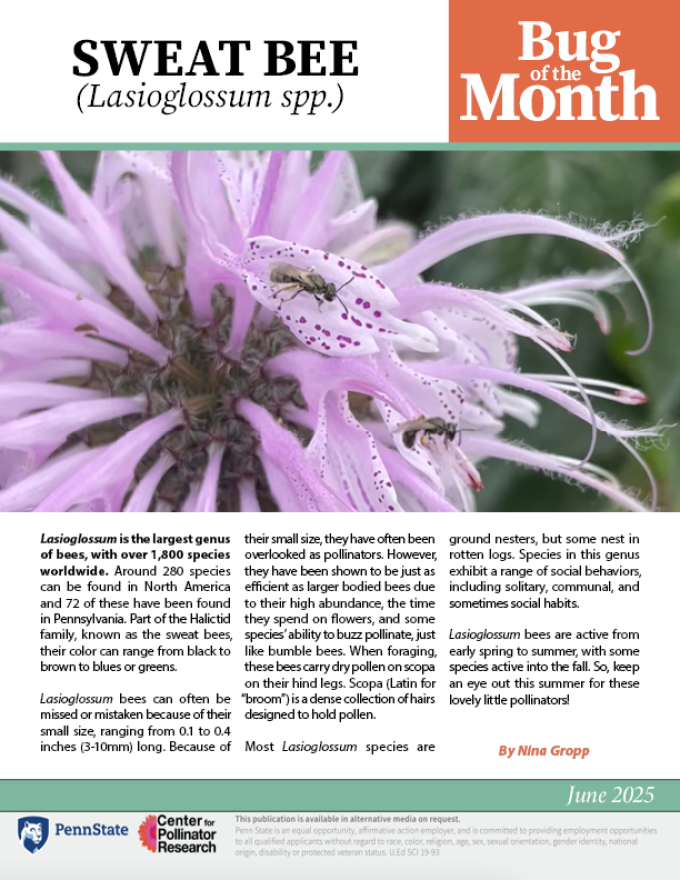
Bug of the month: Lasioglossum spp.
The June 2025 Bug of the Month is the sweat bee, Lassioglossum spp.
By Nina Gropp

Bug of the Month: Lycorma delicatula
The May 2022 Bug of the Month is Lycorma delicatula, the spotted lanternfly.
By Laura Laiton Jimenez

Bug of the Month: Macrodactylus subspinosus
The October 2022 Bug of the Month is Macrodactylus subspinosus, the rose chafer.
By Laura Laiton Jimenez
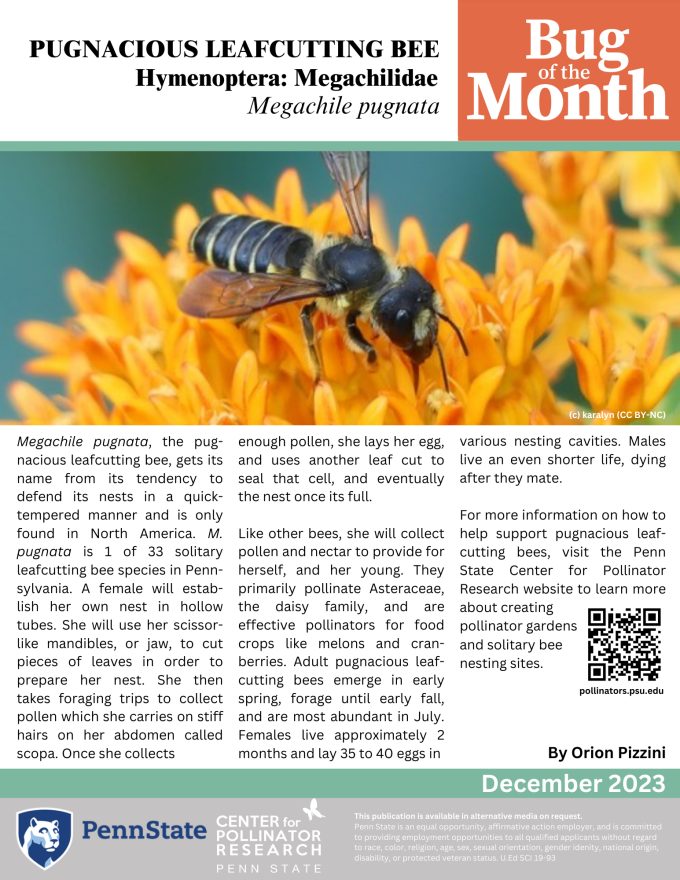
Bug of the Month: Megachile pugnata
The December 2023 Bug of the Month is Megachile pugnata, the pugnacious leafcutting bee. By Orion Pizzini
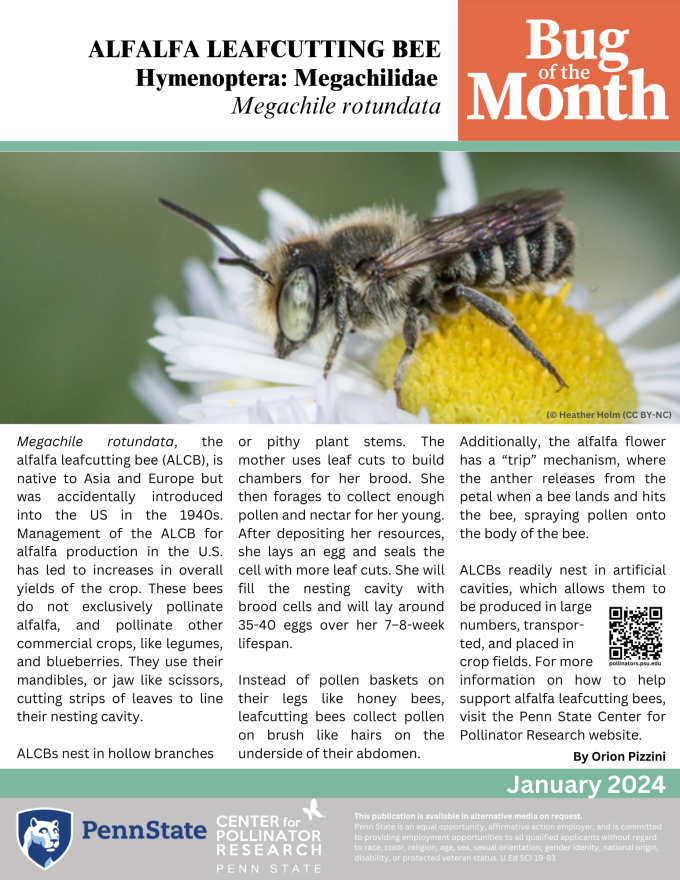
Bug of the Month: Megachile rotundata
The January 2024 Bug of the Month is Megachile rotundata, the alfalfa leafcutting bee.
By Orion Pizzini

Bug of the Month: Monarch Butterfly

Bug of the Month: Otiorhynchus sulcatus
The December 2022 Bug of the Month is Otiorhynchus sulcatus, the black vine weevil.
By Laura Laiton Jimenez

Bug of the Month: Paralobesia vietana
The April 2022 Bug of the Month is Paralobesia vietana, the grape berry moth.
By Laura Laiton Jimenez

Bug of the Month: Peppered Moth
The November 2025 Bug of the Month is the Peppered Moth, Biston betularia
Written by Natalie Boyle

Bug of the Month: Pine Needle Scale
Pine needle scale is a tiny armored scale insect that becomes especially noticeable in winter, when its white, oyster shell–shaped coverings stand out against dark evergreen needles.

Bug of the Month: Popillia japonica
The September 2022 Bug of the Month is Popillia japonica, the Japanese beetle.
By Laura Laiton Jimenez

Bug of the Month: Psephenus species
The June 2021 Bug of the Month is Psephenus species, or water penny.
By Francesca Ferguson

Bug of the Month: Pseudococcus maritimus
The February 2023 Bug of the Month is Pseudococcus maritimus, the grape mealybug.
By Laura Laiton Jimenez

Bug of the Month: Rhyacophila species
The December 2021 Bug of the Month is Rhyacophila species, green caddisflies.
By Francesca Ferguson
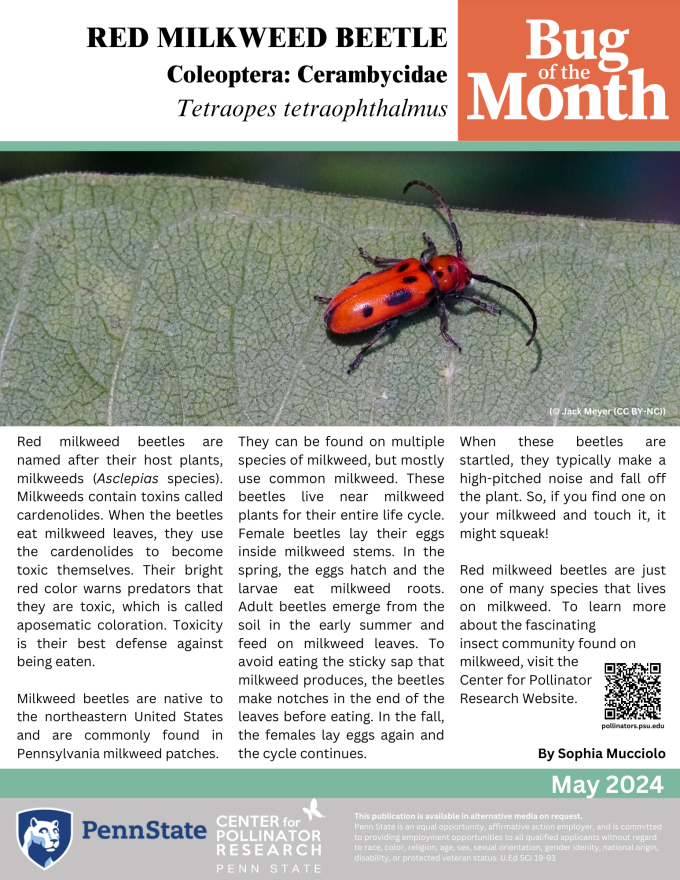
Bug of the Month: Tetraopes tetraophthalmus
The May 2024 Bug of the Month is Tetraopes tetraophthalmus, the red milkweed beetle.
By Sophia Mucciolo

Bug of the Month: Tiger Beetles
The September 2025 Bug of the Month is the tiger beetle, which are fast-moving, brightly colored predators that use their speed and sharp vision to chase down prey on the ground. Written by PSU Ecology student Nina Gropp.
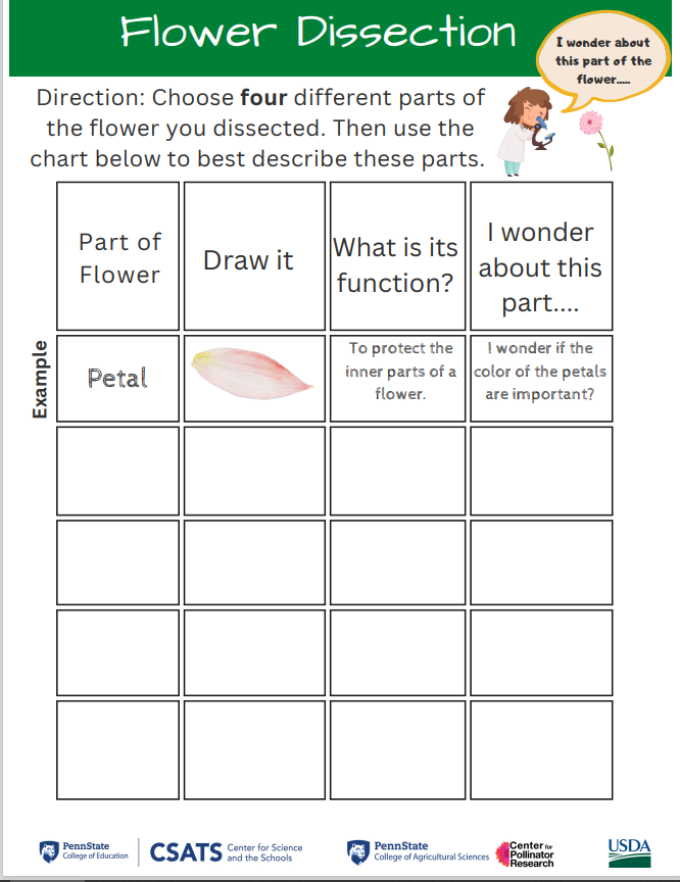
Darwin's Orchid
Grade Level: Fourth Grade, Life Sciences
Overview: Students will learn about the importance of studying plant structures to understand how it grows. Students will learn the study of plants, Botany. The class will learn about the naturalist, Charles Darwin and his study of the Star Orchid. They will learn that Darwin was able to determine that the only pollinator able to drink nectar from this plant was the Wallace’s Sphinx Moth, known for its extremely long tongue. Darwin was able to predict this pollinator by investigating in a flower dissection of the Star Orchid. Students will model similar duties of a botanist by investigating in their own flower dissection. In a science journal, students will illustrate, label, and describe their given flower. Students will also predict what possible pollinator(s) would visit their flower based on the plant’s internal and external structures.
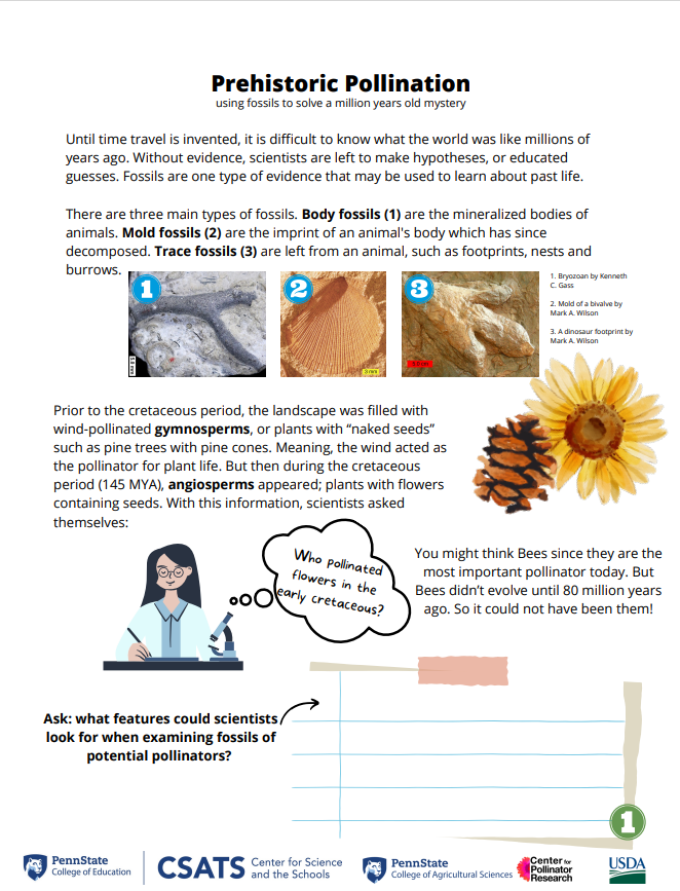
DIY Plant Fossils
Grade Level: Third Grade, Life Sciences
Overview: Students will learn about the study of fossils, Paleontology. Students will learn how analyzing fossils helps scientists understand what Earth was like thousands of years ago, including plant life. Students will then study about fossils using real plant trace fossils. The teacher will then guide students outside and they will have to choose a native plant and make a trace fossil using a guided recipe. Students will use a science journal to illustrate and write scientific descriptions of fossils based on the trace fossils created from their peers. The class will have to analyze the fossils to provide evidence of the local environment in which they live.
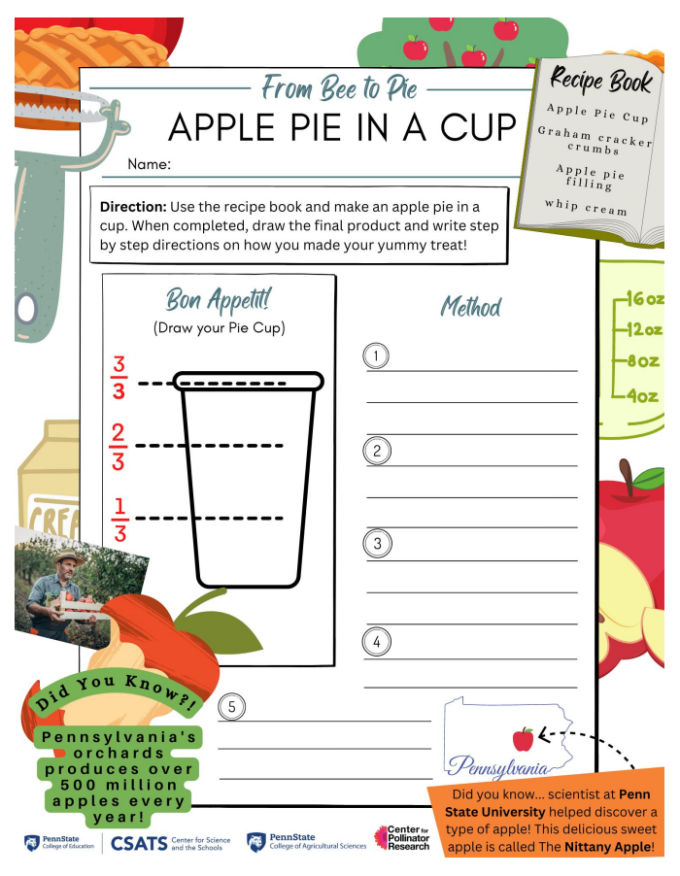
From Bee to Pie
Grade: First & Second Grade, Environmental Literacy
Overview: In this lesson, students will learn about the importance of agriculture in the state of Pennsylvania. In particular, they will learn about apple orchards and the key role pollinators play in the reproduction of apples. Students will learn the process from apple blossom to fruit to harvest to distribution to table. Students will then get to make their own apple pie cup using math fractions to demonstrate measurement skills. Finally, Students will get to enjoy their yummy treat while learning about the human impact in agriculture.
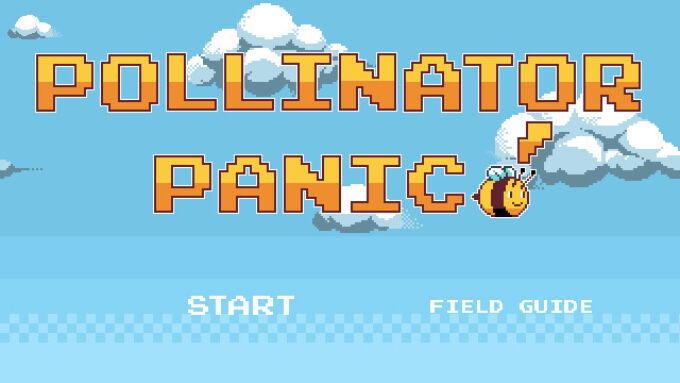
Game Instructions: Pollinator Panic!
Follow these instructions to play Pollinator Panic! An online strategy game that allows a player to assume the role of a field researcher who is working to restore a bee community.

Game: Pollinator Panic!
An online strategy game that allows a player to assume the role of a field researcher who is working to restore a bee community.
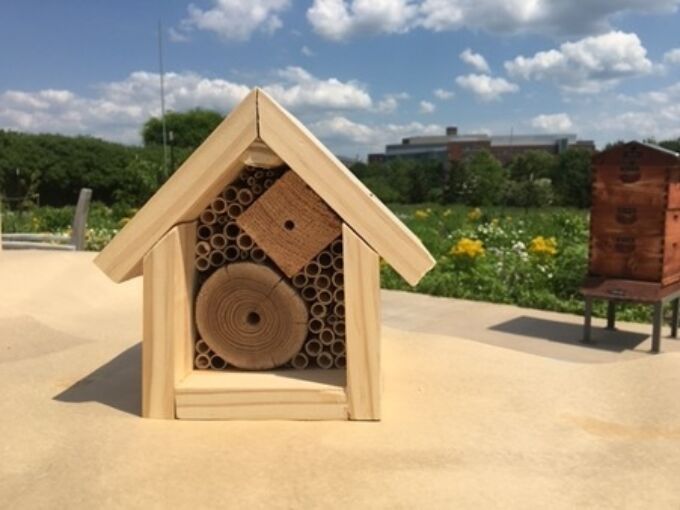
How to Construct a Bee Hotel
A step-by-step guide for how to build your own bee hotel, complete with templates!
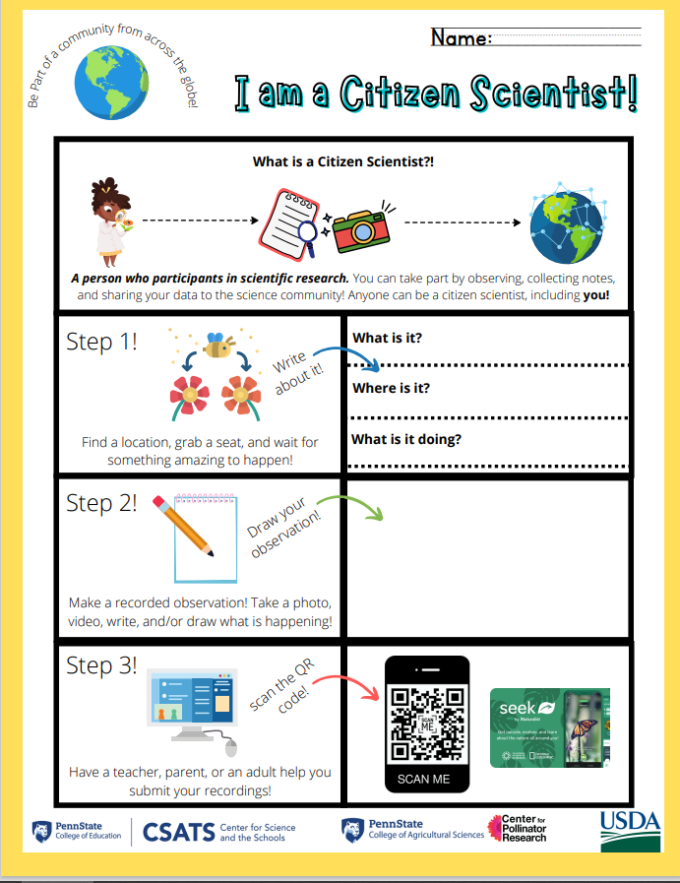
I am a Citizen Scientist!
Grave Level: K-5th grade, Environmental Literacy & Technology
Overview: Students will learn what it means to be a citizen scientist. Students will learn about the process of making observations, collecting & recording data, and sharing data to the science community. The teacher will guide students to a designated area outside of the classroom. Students can work independently or in small groups to observe a pollinator or plant. Students will use the guided worksheet to complete the data collecting process. Students will then take their work and upload it to the kid-friendly open source data app, Seek by iNaturalist. Students will then work together to share their data with the class.
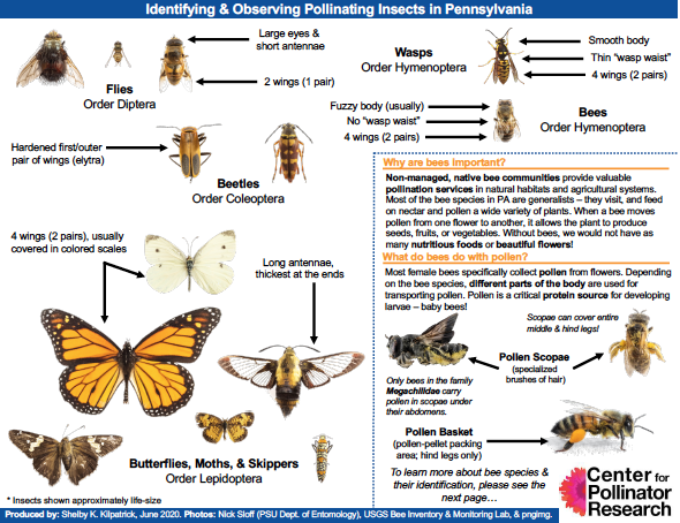
Identifying and Observing Pollinating Insects in PA
Use this two-page guide to identify common Pennsylvania pollinators, many of which look similar to each other. Page one provides key features to differentiate bees, flies, wasps, beetles, butterflies, moths, and skippers. Page two explains differences between different types of bees.
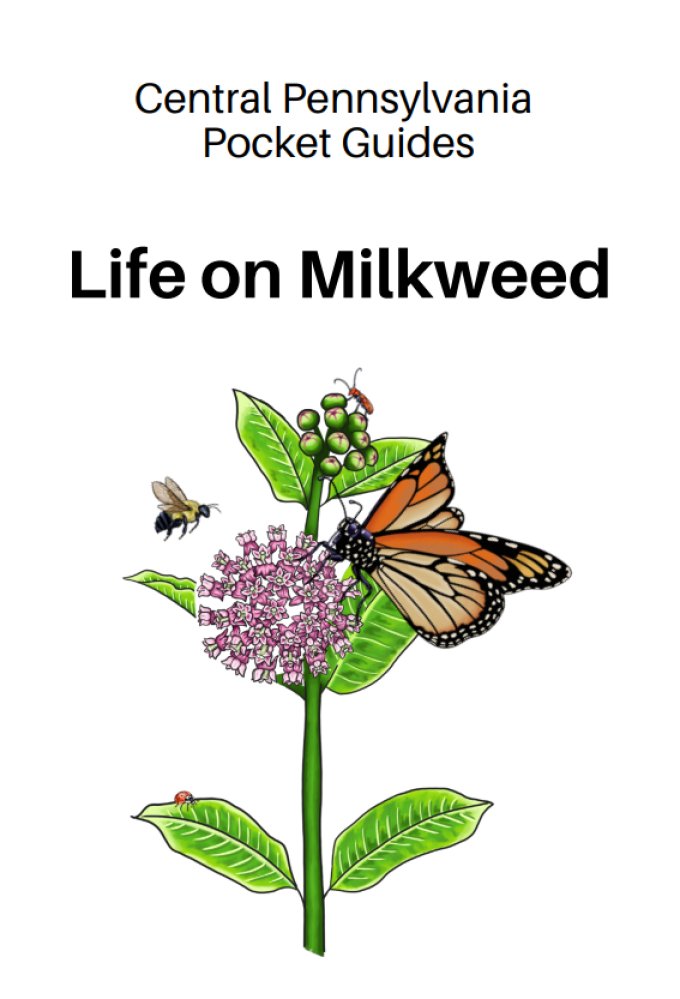
Life on Milkweed
Who lives on milkweed? There is a bustling community of insects waiting to be discovered, each with their own survival superpowers!
Life on Milkweed was created by Heather Frantz and Lilly Germeroth. Illustrations produced by Michael Hill.
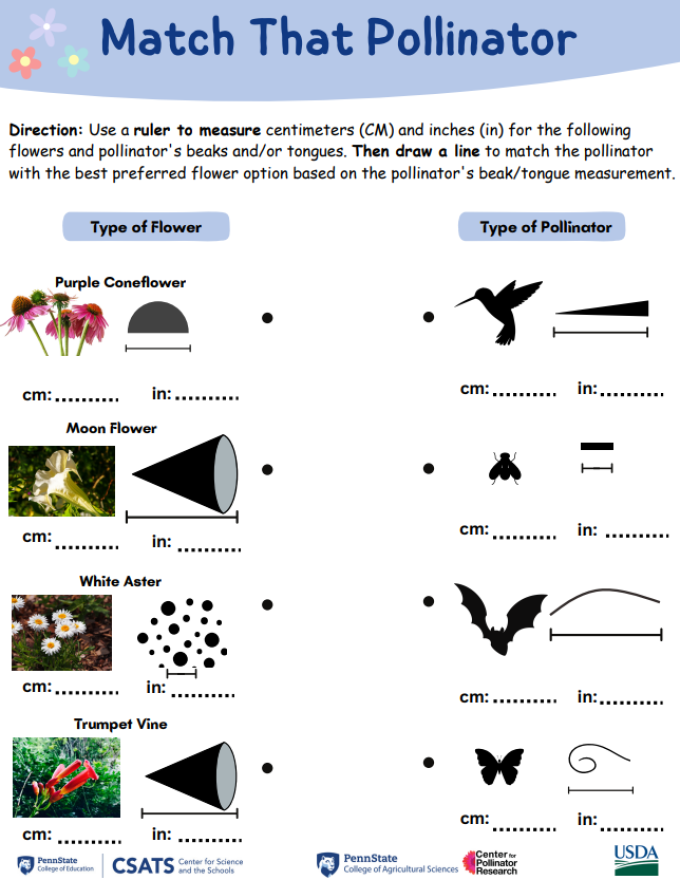
Match That Pollinator
Grade Level: Third Grade, Life Sciences
Fifth Grade, Math- Measurements
Overview: Students will learn about the correlation between plants and pollinators. Students will review how plant growth is dependent on visiting animals and insects such as bees, beetles, hummingbirds, butterflies, and etc to pollinate. But just like humans, pollinators do enjoy the nectar from certain types of plants. Students will investigate and measure different pollinator’s structures to predict what types of plants these pollinators collect nectar and/or pollen from. During the activity, students will model similar roles of an Entomologist. Scientists who study insects and the importance of pollination for species to thrive. Overall, students will gain knowledge of how both plants and animals need each other to survive in regards to food and reproduction.
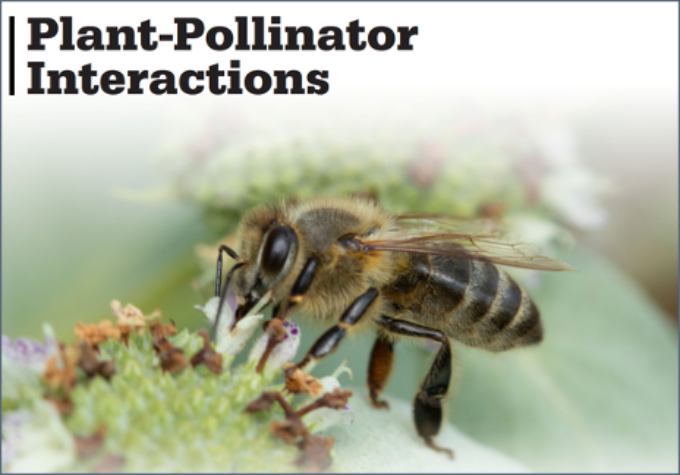
Plant Pollinator Interactions Lesson Plan
This lesson plan guides students to understand plant-pollinator interactions. Students will be able to recognize the mechanisms governing pollinator attraction to floral types and understand how plant-pollinator mutualisms may have contributed to species diversification through co-evolution.
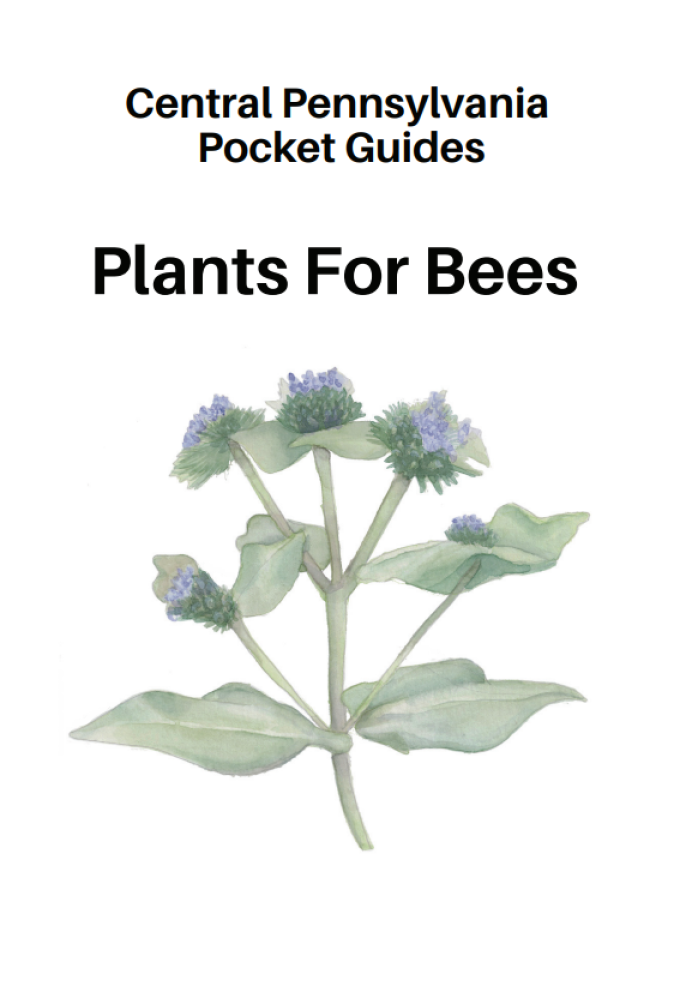
Plants for Bees
Beloved residents in our gardens, bees are the most effective pollinators. Pennsylvania is home to 437 species and there are at least 4,000 species of bees in the United States representing six of the seven families.
This pocket guide has a list of garden plants beneficial for bees.
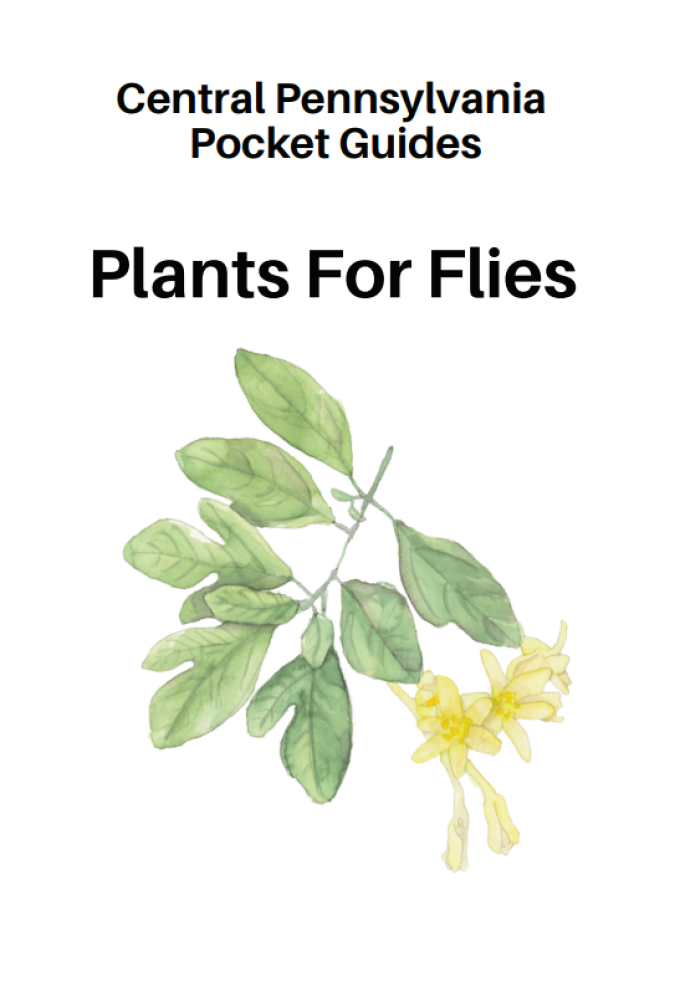
Plants for Flies
The importance of flies as pollinators should not be underestimated. In fact, flies are the second most important pollinators after bees. They have been reported to visit flowers of 172 plant families and this is likely to be a conservative figure.
This pocket guide has a list of garden plants beneficial for pollinating flies.

Plants for Hummingbirds
Hummingbirds do not feed on pollen like bees. However, hummingbirds inadvertently collect pollen on their head feathers as they drink nectar from tubular flowers. In this way they are the best bird pollinators of the New World.
This pocket guide has a list of garden plants beneficial for hummingbirds.

Pocket Field Guide to Night Singing Insects of Pennsylvania
The sounds of insects during summer nights in Pennsylvania are abundant. The chirping of crickets, singing of katydids, and buzzing of coneheads fill the outdoors- from forests to neighborhoods.
Explore the night singing insects of Pennsylvania with this pocket field guide.
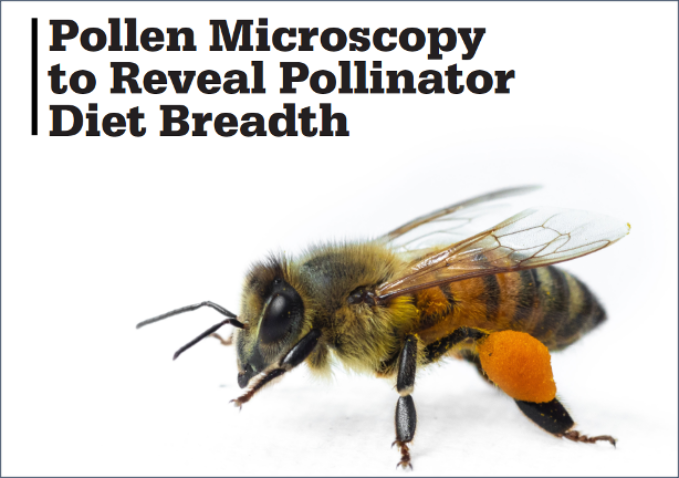
Pollen Microscopy Lesson Plan
In this lesson, students will discover the intricacies of pollen morphology through field observation and sampling skills.
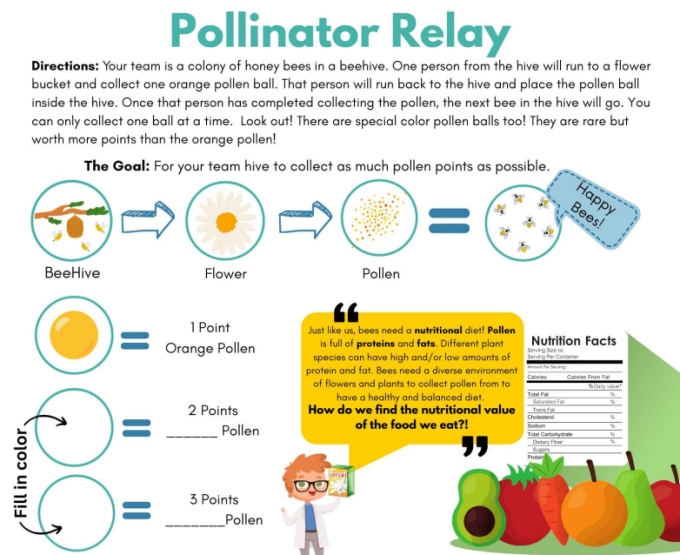
Pollinator Relay
Grade Level: Second Grade, Life Sciences
Overview: In this lesson, students will learn how honey bees pollinate flowers. Students will also learn how different types of flowers have unique blends of pollen nutrition. Pollen provides bees with a blend of protein and lipids. Just like humans, our food sources are full of nutrients and give us energy throughout the day. Students will demonstrate understanding of bee pollination by embodying honeybees. The teacher will guide students outside to model bee pollination by playing the game, Pollinator Relay. Students will act as a colony of bees in beehives. There will be flower buckets acting as a cluster of different types of flowers. Each bucket will be full of pollen balls, (ping pong balls). The flower buckets will be located around the beehive. One bee at a time will leave the hive to collect pollen. The goal is for students to work together and to collect as much pollen as possible. Students will also receive “extra pollen points” when collecting different types of pollen that are enriched with high protein.
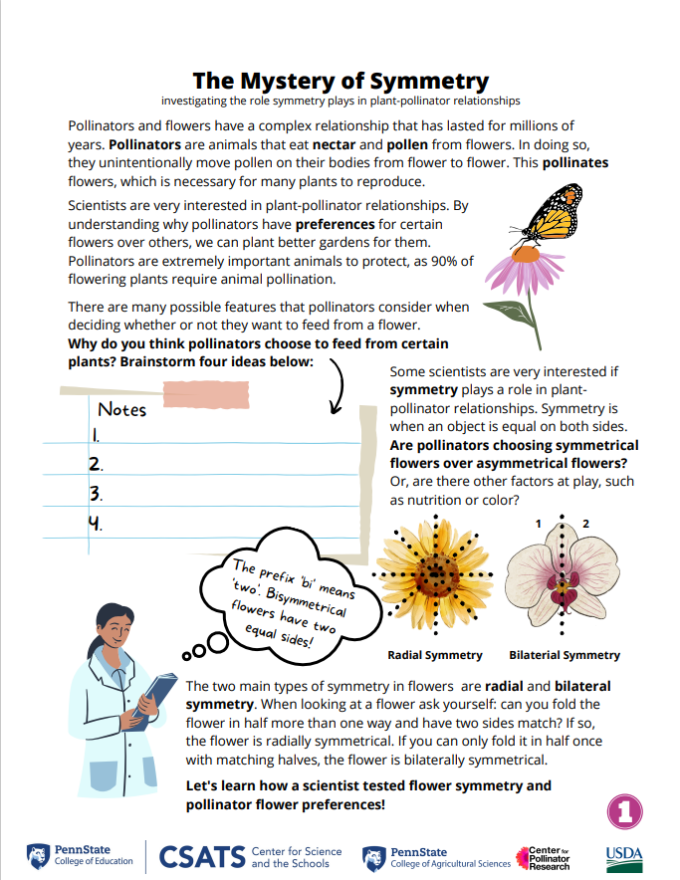
Pollinator Symmetry
Grade Level: Fourth Grade, Life Sciences
Overview: In this lesson, students will learn about the key role of bilateral symmetry in pollinators and flowers. Research scientists have observed the phenomenon of pollinator attraction to the color and to symmetrical appearance of plants. In fact, many animals and insects are symmetrical. This symmetry is important to the reproduction and survival of plants. Students will take this given knowledge and create bilateral symmetrical pollinators. Students will have to draw the mirror image by using mathematical shapes and lines. Students will then use a method of painting and folding to create a symmetrical insect and/or flower.

The Bug of the Month: Melanoplus differentialis
The January 2022 Bug of the Month is Melanoplus differentialis, the differential grasshopper.
By Francesca Ferguson

The Bug of the Month: Tipula species
The October 2021 Bug of the Month is Tipula species, common craneflies.
By Francesca Ferguson
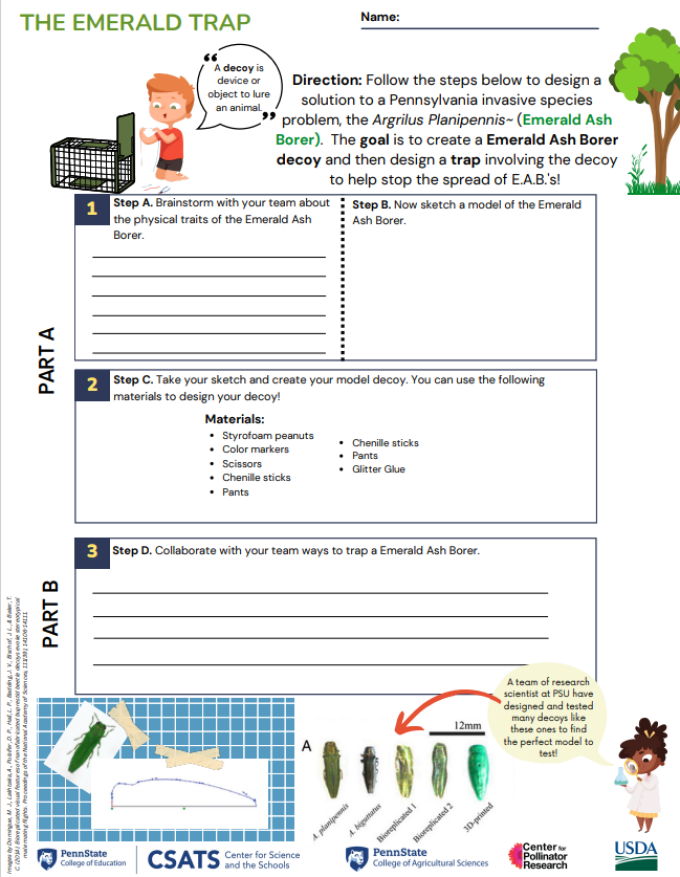
The Emerald Trap
Grade Level: K-2nd Grade, (Environmental Literacy)
Overview: Students will learn about the invasive species, the Emerald Ash Borer, E.A.B.. Students will learn how this invasive species is responsible for the deconstruction of millions of ash trees, a key plant in Pennsylvania’s ecosystem. Students will learn of different ways to protect our ecosystem from this invasive species. Students will then make a Emerald Ash Borer decoy and design a trap to collect this specimen. Students will observe and collect data on their traps. Finally the class will have a discussion on possible variables and solutions to control this science experiment for future testing. For best trap results, a prism trap up in the tree is best. (Information on “best” traps is located in teacher resource videos.) The goal of this activity is not to collect the most E.A.B. but rather having students critically think and practice by making their own designs and finding solutions. Students should be given the opportunity to discuss and make their “ideal” trap.
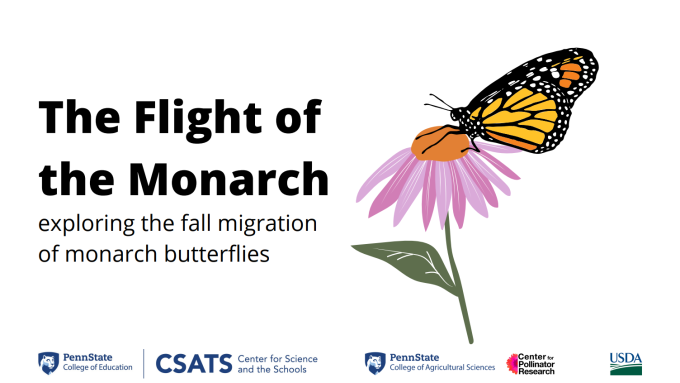
The Flight of the Monarch
Grave Level: K-2nd, (Environmental Literacy) & Focus on 1st grade.
Overview: Students will learn about the Monarch butterfly's great winter migration to central Mexico. Scientists have studied over the years the phenomenon of these amazing pollinators migrating to the same location every year. It takes two to three generations of monarch butterflies to migrate north from Mexico through the U.S. up to Canada. When returning later in the year, the monarchs develop a 'Super Generation' to make the longest leg of the journey southward, for the winter migration. Students will learn how Monarch Butterflies are able to migrate south not due to parent trait but rather a natural compass internal within their body. Students will design a monarch butterfly and insert a compass. The class will learn what a compass is and how to use one to help navigate. The teacher will then guide students outside to model as the butterfly, navigating south and then north. Students will use the compass to direct its Monarch butterfly to migrate. Overall, the class as a whole will move in the same direction similar to Monarch butterflies moving to the same direction to migrate.
To access a Spanish version of this lesson plan please visit this link
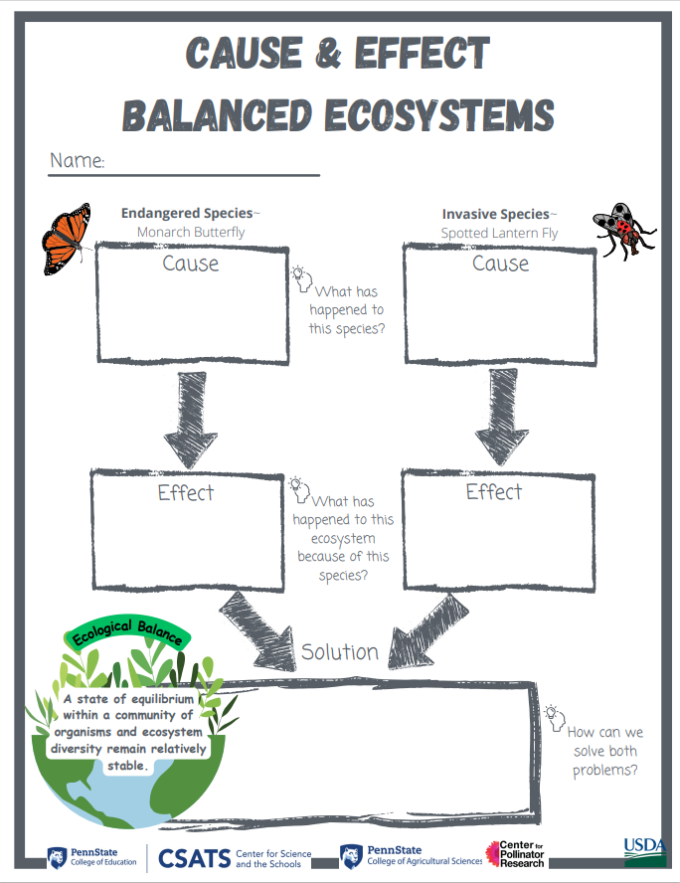
The Million Dollar Fly
Grade Level: 3rd-5th grade, (Environmental Literacy) focus on 5th grade
Overview: Students will learn about the term invasive and endangered species. Students will learn about The Spotted Lanternfly, an invasive species that is destroying Pennsylvania’s agriculture and ecosystem. The class will gain knowledge on the negative impacts this species has caused to Pennsylvania agriculture in grapes, apples, and the hardwood industries. Students will also learn why it is crucial for STEM-related careers in agriculture to create solutions to control this state environmental issue. Students will study and design “Wanted Bug” flyers to promote awareness to the community. Students will also plant milkweed within their community as a natural way to control the spread of the Spotted Lanternfly and promote growth with the endangered species, the Monarch Butterfly. Students will see the importance of having a balanced ecosystem.
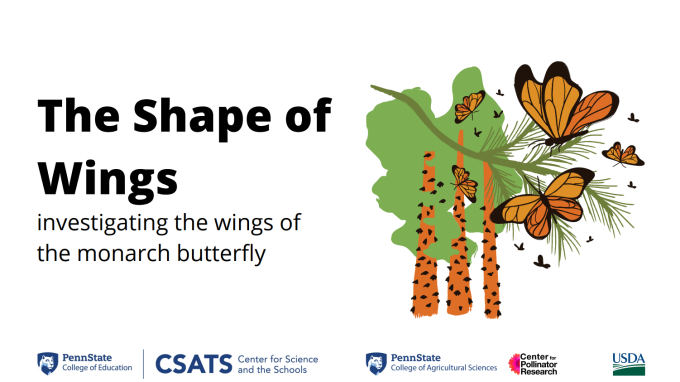
The Shape of Wings
Grade Level: First Grade, Life Sciences
Overview: Students will learn about the Monarch Butterfly and their amazing wings. This species uses its wings to not only travel but as well as protect itself from predators. The bright orange and district black shapes on the wings are to warn predators not to “eat me”. These wings are actually poisonous to digest and even though they have a beautiful appearance, is a physical attribute to warn others. The most important key role of these wings are the natural engineering design for the ability to travel far. Given the ability to fly thousands of miles to migrate, the Monarch’s large and flexible wings give them a burst of propulsion. Students will learn how research scientists have discovered that these wings "clap" together, squeezing out the air between with such force that it thrusts them forward. Students will gain knowledge of these wings and create their own Monarch butterfly model. Students will design wings using shapes and color. Then students will take their designed wings and taped them onto a balloon. Students will model the “clapping” motion by pushing down on the top center of the balloon, between the wings. Students will observe their designed wings “clapping” back and forth, similar to the Monarch when flying. Finally, students will learn that humans have studied structures of animals to mimic similar movement in many man-made inventions such as cars, airplanes, and boats.
To access this lesson plan in Spanish and accompanying audio files, please visit this link
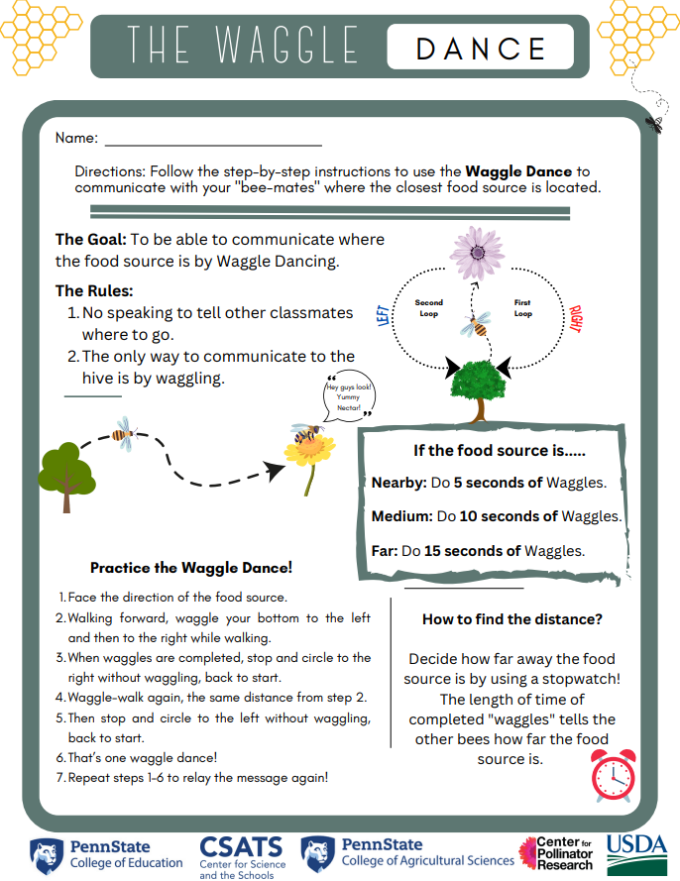
The Waggle Dance
Grade Level: Third Grade & Fourth Grade, Life Science
Overview: Students will learn about the importance of communication among species, focusing on the dwarf honey bee, Apis florea. Students will learn about the Waggle Dance, a way for bees to inform and receive information about new food sources. Students will also learn about the importance of collecting pollen and nectar as a food source for the whole hive. Students will participate in modeling this process through embodiment. As teams, students will act as worker bees in a hive. Students will have to work together and dance as a form of communication to explain where the local food sources are. Students will model similar movements bees use when demonstrating the Waggle Dance. Students will also receive time to discuss and reflect on ways to improve communication within their own hive.
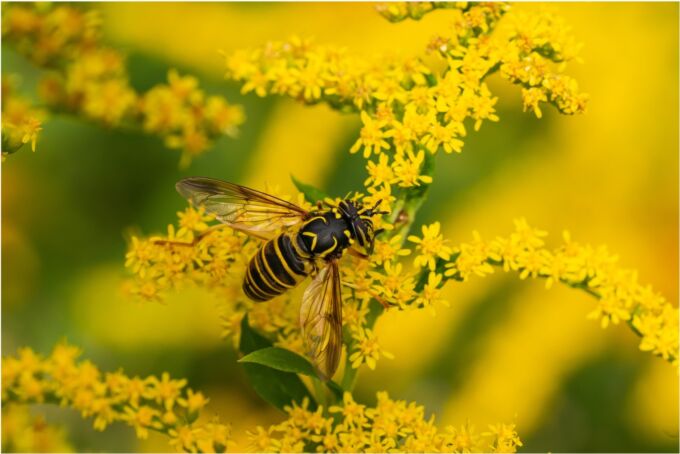
What is a pollinator?
Every plant that flowers requires pollination to reproduce. Learn what a pollinator is and why they are so important to our ecosystem.

Where in the World is R.T. Hummingbird?
Grade Level: Second Grade, Life Sciences
Overview: In this lesson, students will learn about the Pennsylvania state hummingbird, The Ruby-Throated (R.T.) Hummingbird. Students will learn how this special hummingbird is a natural pollinator and its amazing annual journey through the United States. Students will work together to discover this pollinator’s migration route through North America. Students will receive 5 diary passengers written from R.T. Hummingbird who is migrating north for the summer months. Each diary passage has geological context clues. Students will use the clues and a physical region map as a key to help guide them into finding the correct 5 locations. Students will then connect the 5 location spots to observe the northern migration route of the R.T. Hummingbird. Students will also learn about different types of flowering plants that grow due to an environment and how animals adapt to change.

Will bees like it here? Data Collection Worksheet
Use this worksheet to collect data for the lesson plan "Will Bees Like it Here?"

Will bees like it here? Lesson Plan
In this lesson, students will evaluate two habitats for nesting and floral resources for wild bees and compare their evaluations to observed pollinator activity. Students will participate in collecting and recording data after hypothesizing habitat quality based upon the number of pollinators and pollinator diversity. Students will communicate the results of the investigation to their peers.
